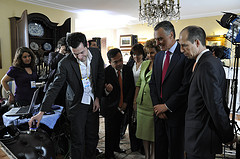I’ve failed to keep in touch with the cool things happening in Second Life®, and this one definitely was quite an encouraging one: US President Barack Obama, while on his state visit in Ghana, streamed his address to audiences in Second Life and Metaplace, something which for some reason failed to escape the watchful eyes of most of the mainstream media.
Thankfully, we can rely on our faithful in-world journalists Draxtor Despres and PalUP Ling to keep us up to date with the breaking news:
One month after Portugal’s own President effectively became the first nation’s president to address an audience in a virtual world, comparisons are obvious. Crap Mariner very thoughtfully claims that Barack Obama was not in SL at all; Crap’s argument is that basically this was just the work of Obama’s political spin doctors. Obama might not even have been aware that his speech in Ghana was being streamed at all.
Nevertheless, the President of the United States of America might probably not have been aware that his face was on wide screens all over Second Life (and Metaplace), but that doesn’t mean his staff was clueless. In fact, from Drax’s video, you can see that a debate (with some Lindens in attendance) was organised afterwards, and it was hinted that members of Obama’s staff were present. They also claim in the CBS article (linked above) that this was specifically organised, not just a bunch of residents throwing up a few in-world screens and linking to the screen; so it’s unfair to say that “Obama was not in SL”. His avatar wasn’t, but his RL team was. That, ultimately, is the difference between “having the President” in SL and “having the Presidency” in SL (Obama represents the Presidency, but the Presidency, as an institution, reaches further than the physical presence of the US President).
Contrast this to the approach taken by Portugal’s Presidency. It was not only the “staff” that was aware of the President’s speech in SL. First and foremost, they have endorsed a virtual presence in Second Life — not paid for it, because it was felt that taxpayer’s money could be better employed elsewhere. Instead, volunteers (both individuals and organisations) were encouraged to participate in setting things up, but there was a theme and a purpose which was clearly defined from the start (in this case, bridging the distances separating Portuguese communities all around the world). The date and place for the official address was publicised on the official website, and, although there was no concern of making a huge media splash out of it, the Presidency of the Portuguese Republic definitely used social media tools to promote the event, feeling — probably rightly so — that people already connected through online social media would be a better target for this event than the mainstream, unconnected population.
During the day of the presidential address, things were also quite different. Obama was basically addressing a real life audience (we can see it on the video). A digital camera was just capturing the video and also streaming it into SL. So it was not a special event just for virtual worlds, but a one-sided mixed-media event, where a RL event is transmitted life into SL, and discussed there afterwards (but no feedback was pushed to the “real” side of the event).
Portugal’s President Aníbal Cavaco Silva never faced a real audience. He was shot with a digital camera and this was streamed live and in real time into SL; of course the video was also captured to be disseminated later to YouTube and Sapo Vídeos (a popular video hosting site in Portugal). After some discussion, it was felt inadequate to have the Portuguese President’s avatar (created in 2007 by Cavaco Silva himself!) walk around and chat with the residents (this might happen in the future, though), but that doesn’t mean that the President just walked into a room, delivered his speech to a camera, and went away to the next event.
 In fact, as this picture to the left shows, the President waited for the reactions and was looking at the spontaneous chat in SL after his speech — from his smile, it seems that he was amused 🙂
In fact, as this picture to the left shows, the President waited for the reactions and was looking at the spontaneous chat in SL after his speech — from his smile, it seems that he was amused 🙂
It’s unfair to make these comparisons, of course, since after all, my point is not that one is “better” than the other, but that both are official ways to bring the world’s leaders closer together to their citizens, using social networking tools and, most importantly (for me!), virtual worlds. Both have different styles and possibly different goals. In my mind, I can only say that a presence that involves community participation tends to be longer-lived and more genuinely felt as being a serious wish to be part of it, and not merely a political marketing campaign; nevertheless, the after-speech debate that apparently followed Obama’s address was probably more interesting, more well-planned, and more long-lasting in people’s memories than the spontaneous conversation that arose in the Portuguese case. A combination of both would probably be most welcome; adding to either case a few minutes having the President logging in to SL and answer a few questions (Obama’s staff, for instance, is well acquainted with SL and could fully moderate such a session with ease, since they have studied it long ago and prepared the whole in-world election campaign with great success; Cavaco Silva’s staff is less proficient with SL at this moment, but Cavaco Silva knows SL, and his staff has been around for a year or so, submitting to SL training, and getting reports about virtual worlds every other week).
So, no, I’m not suggesting that Obama copies another idea from Portugal 🙂 Just that each presidential staff has their own style of being in Second Life, and it’s unfair to say that “Obama was not really in SL” when that clearly was not the case.




